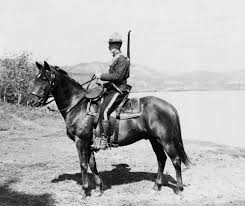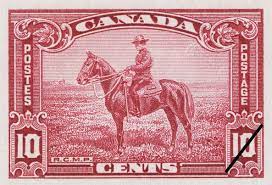Early in the spring of 1916 the patrol again took up the trail and crossed over the Divide to the Coppermine River, thence down that stream to Coronation Gulf on the Arctic. Here they were fortunate in falling in with Corporal Bruce, one of the members of Stefansson’s expedition. Although he had heard nothing of the murdered priests, he had succeeded in becoming well acquainted with the natives, and it was through his good offices that track was eventually found of the men who had done the deed. One was discovered on South Victoria Island, while the other was arrested on an iceberg out in Coronation Gulf.
All told Inspector La Nauze travelled close upon three thousand miles to secure these men, the journey occupying over a year. With the two prisoners he proceeded to the post at Herschel, where a constable was dispatched home with the reports.
From Herschel the prisoners were brought to Edmonton, a distance of over 2,500 miles. According to the story they told they met the missionaries on their way up the Coppermine River. A storm was raging at the time, and the missionaries prevailed upon them to assist the dogs dragging the sledges. As the storm grew worse, the Eskimos became scared that they would be overwhelmed and sought to turn back for shelter. The priests, however, were determined to go forward. Angry words followed to be succeeded by _____, the blinding storm kindly draws the veil upon the scene.
Cruel, raw, elemental, like the iron country which witnessed it, the quarrel could have but one conclusion. Had it not been that the murderers appropriated and wore the garments of their victims the fate of the missionaries might have remained a mystery forever, as these garments afforded the only clue. Whether this was actually the case or not will never be known. Anyhow public sympathy was with the Eskimos; they were found not guilty, and went back to the Arctic greatly pleased with seeing the wonders of the white man’s land.

SIX YEARS on the TRACK of JUSTICE
A still more remarkable patrol was that for the murderers of Harry Radford, the famous Arctic explorer of New York, and his companion Street, who were speared to death by Eskimos in the Bear Lake region of Hudson Bay in 1911. News travels slowly in these desolate regions, and it was not until 1913 that a patrol of the North- West Mounted Police was dispatched to secure, if possible, the two Eskimos who had committed the crime.
Inspector W.J.Beyte was in charge of the party, with Sergeant Calkin and two others. From Regina they went by train to Halifax, a distance of over two thousand miles, where they took the schooner Village Belle, especially chartered to take them into the wilderness.
The schooner sailed for Hudson Bay, and on the trip had numerous miraculous escapes from icebergs and ice floes, and was nearly wrecked several times. Finally Chesterfield inlet was reached.
NEXT WEEK- the conclusion.
